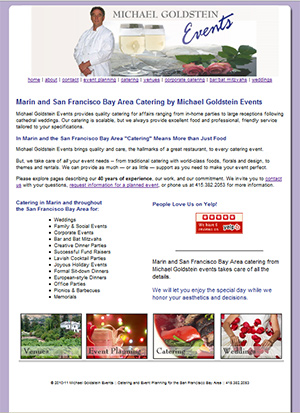[NO] Speed Kills… Your Google Ranking
Search Engine Optimization gurus — the people that get your site to come up on the top of Google results — are saying that how quickly your web pages display is an increasingly important factor in determing where you show up in the list of relevant sites that Google returns to your potential customers.
If your site is slow, Google will drop it down low on the results because Google thinks that its users are impatient. So, if you have useful information that takes 10 seconds to display to a visitor, your site may be down the list of competing sites with inferior data if they show up in less than a second.
Google’s focus on speed impacts your choice of the technical platform of your site, its hosting service, and additional support.
To ensure a quick site, you may:
- Use simple HTML for your pages instead of pages built with scripts such as those used by WordPress.
- Purchase third-party services designed to improve the availablity of your site throughout the Internet.
- Sign-up for a beefy hosting plan that is designed to serve up WordPress pages.
Third-party services that cache the site and deliver the pages from different servers around the contry/world by can greatly improve the responsiveness of static, HTML site. We use one called Cloudflare.
Check out two of our simple HTML websites that use Cloudflare:
Fast, huh?!
But, Cloudflare cannot improve the speed of dynamic sites so dramatically. If you have a site built on WordPress where some of the page content is created each time a visitor clicks to see it, Cloudflare won’t help. And, even WordPress pages without content that is obviously changing come back more slowly than sites using only HTML.
The two sites above are basic HTML sites. Their corresponding WordPress blogs are also on Cloudflare. But, they are not nearly as quick. See:
- San Francisco CPA blog
- This blog served by Cloudflare.
Pages on these WordPress sites — even sites using Cloudflare — take longer to show up on your screen than the HTML sites.
To improve the speed of WordPress sites, you can purchase high-powered hosting plans. But, those beefy services cost many times the typical $125/year charge most of our clients pay for hosting. (See Synthesis‘s pricing. They are a service that is focused on supporting the needs of WordPress sites, and their “starter” plan is $324/year.)
WordPress offers a lot of advantages for business owners and their designers. But, WordPress comes with a handicap. It’ll be slower unless you spend extra money on hosting and also use care in turning on add-on functionality that require CPU cycles to produce a page.
Let’s talk about your need to be high in Google rankings, your need to do updates to pages yourself, and your budget for hosting services!

